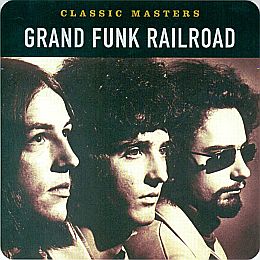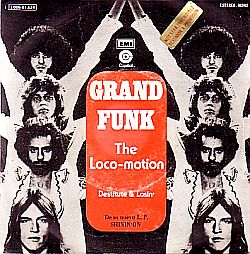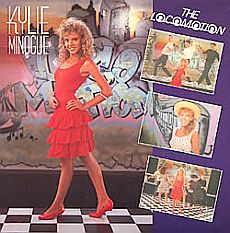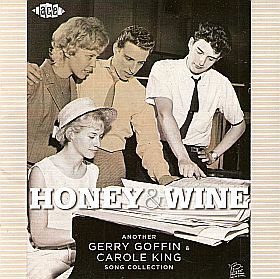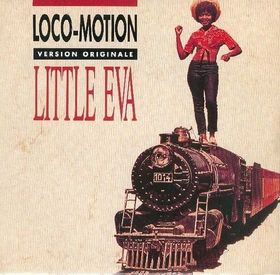
‘Little Eva’ Boyd of the 1960s shown on a later 2001 U.K. CD of her songs by Dimension recordings. Click for CD.
In 1962, sixteen year-old Eva Boyd was working as a live-in domestic and babysitter for the famous 1960s songwriting husband-and-wife team of Carole King and Gerry Goffin. King and Goffin were one of the teams that music publisher Don Kirshner had assembled at New York’s famed Brill Building, where a long list of successful pop music hits were hatched in the mid-1950s-through mid-1960s period. In Little Eva’s case, some of her innocent on-the-job dance moves and singing while babysitting led to a Goffin-King song idea that became “The Loco-Motion.” According to one 1963 story that ran in The Saturday Evening Post, the alleged “inventive moment” was reported to have occurred as follows:
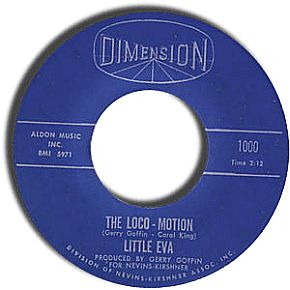
A 45 rpm record of "The Loco-Motion," Little Eva's No. 1 hit of 1962, on the Dimension record label. Click for vinyl.
“…While the lady of the house [Carole King], a girl only two years the baby-sitter’s senior, walked about the apartment bouncing her daughter to the rhythm of new melodies being born in her head, the baby-sitter [Eva Boyd] dusted, polished, cleaned and picked up to the same bounce. Sometimes she even learned the songs and sang them almost before her employers had finished writing them…. And one day, as Carole sat conjuring up a new tune, Eva went so far as to invent a dance to it. ‘What you’re doing reminds me of a locomotive!,’ exclaimed Carole’s 22-year-old husband [Gerry Goffin]…watching Eva dance.
“Then, poof! In a cloud of smoke—because Gerry was chained to cigarettes—he used his magic wand—a pencil—to write words on a pad. Abracadabra! And lyrics appeared describing Eva’s dance. Sorcerers Carole King and Gerry Goffin had just conjured up a song called ‘the Loco-Motion’…”
|
“The Loco-Motion” Everybody’s doin’ a brand new dance now You gotta swing your hips now Now that you can do it, let’s make a chain now [Instrumental bridge] Move around the floor in a Loco-Motion You gotta swing your hips now Come on, do the Loco-Motion _____________________ |
Making A Hit
A somewhat similar account of the Little Eva/King/Goffin moment has been relayed by Vanity Fair writer, David Kamp:
Little Eva: I wanted to be a recording artist—that was my dream. Carole had one daughter, Lulu, and she was pregnant at the time [with her second daughter, Sherry Goffin, born in 1963]. And she asked me did I want to baby-sit. So I said, “Well, yeah, because in between sessions I’m gonna need some money.”
Gerry Goffin: She would always sing along to the songs we were writing in our little apartment. I came up with the idea [to have her sing on the demo]. Ethnic voices were what was in. Unsophisticated voices.
Carole King: Eva sang, and I sang background with her. And it was the first in a long line—right up to and including my next album—of demos that become masters.
Little Eva: Gerry already thought that it would be a hit with me singing. So he took it in to them to listen, Al Nevins and Don Kirshner. And they listened to it, and you know, it just hit ’em.
Gerry Goffin: For a while [after the song became a hit], she said, “Don’t worry, I’m still gonna work for you, I’m not gonna think about being a star.” And then, two weeks later, she’s touring.
Other accounts say the song, or something like it, was first intended for another singer named Dee Dee Sharp, who already had a big hit with her own dance tune, “Mashed Potato Time.”
In any case, Eva Boyd was taken to a New York city recording studio. Originally it was intended that she serve as the singer only for the demo. However, the demo worked out so well that it was released with a few overdubs as the single.
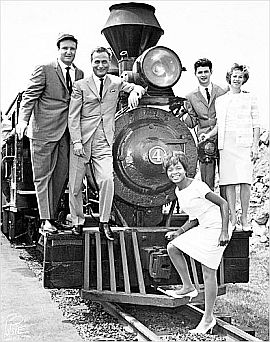
Little Eva shown at front of locomotive engine in 1962 studio promo photo with others, from left: Don Kirshner, Al Nevins, Gerry Goffin and Carole King.
In short order, Eva Boyd became “Little Eva,” and by July 1962, a new dance tune, “The Loco-Motion,” had hit the streets. By the late August 1962 the song was No. 1 on both the Billboard Hot 100 and the R& B charts. It was one of the top “girl group” hits of its day. It stayed in the Top 40 for about 12 weeks and went on to sell more than one million copies, becoming one of the top hits of 1962.
Music Player
“The Loco-Motion” — 1962
Music critic Dave Marsh would later write in his 1989 book, The Heart of Rock and Soul: The 1001 Greatest Singles Ever Made, that “The Loco-Motion” was not so much a song as a sound – “some hand-claps, a baritone sax … there’s a triangle in there, and probably a piano, somebody chanting, ‘come on baby’.” What matters in the end, he says, “is the wholeness of the thing, the unity of the little sounds that add up to one big sound that won’t let you sit still.”
Back in 1962, meanwhile, Eva Boyd soon had her own four-room apartment in Brooklyn and took home some $30,000 in royalties from the recording (1960s’ dollars). Carole King and Gerry Goffin also made about the same amount for their “Loco-Motion”songwriting.
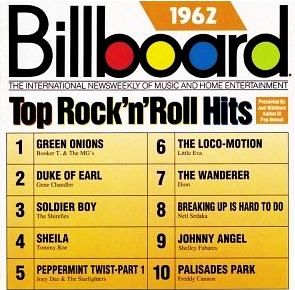
CD cover for a Billboard “Top Hits of 1962” collection, which includes “The Loco-Motion.” Click for CD.
Little Eva, however, did not have another No.1 hit, but she did have a few Top 40 hits including, “Keep Your Hands Off My Baby” in 1962, also by Goffin-King. This tune hit No.12 on the pop charts and No. 6, R&B.
(The Beatles performed a cover version of this song in January 1963 for the BBC, and decades later, it was issued officially on the Beatles Live at the BBC.)
In 1963, Little Eva also had another minor hit with “Let’s Turkey Trot” (No. 20 pop,16 R&B) and she also did a remake that year of Bing Crosby’s “Swinging On A Star” in a duet with Big Dee Irwin which hit No. 38.
Through the early 1960s, Eva Boyd continued to tour and record, but her commercial potential declined after 1964 as the Beatles and the “British invasion” took over the pop charts, ending the reign of many “girl group” acts. Little Eva retired in 1971, but would later return to the oldies circuit.
Grand Funk’s Version
In 1970, Grand Funk Railroad, an American rock band, was among the top recording acts then on the scene. In fact, the group sold more record albums in 1970 than any other American band. A long-playing hit single that year, “I’m Your Captain,” propelled them to fame with an album of the same name — especially with the help of FM radio stations, then playing longer-length songs.
Grand Funk also became a major concert attraction. In 1971 they broke the attendance record set by The Beatles’ at Shea Stadium, selling out a concert date there in just 72 hours.
After the band hired musician Todd Rundgren to refine their sound, they produced two successful mid-1970s albums and two hit singles from those albums – “We’re An American Band” in 1973 and “The Loco-Motion” in 1974, both of which hit No.1 on the U.S. pop charts.
According to one account, the group recorded “The Loco-Motion” on their Shinin’ On album almost as an afterthought. Initially, they joked about it, but later considered doing the song as the Beach Boys had done with another older rock song, “Barbara Ann,” intending it to sound like a party recording with lots of hand clapping, etc.,. Instead, it became one of their most successful singles.Grand Funk’s version of “The Loco-Motion” was released in February 1974, rising to No.1 on the pop charts by March 9th, holding that position for two weeks and then remaining in the Top 40 for another 14 weeks. Although Grand Funk retired in 1976, they would later re-group with some new personnel, continuing to record and perform through the 1990s and more recent years. Videos of the group performing their version of “The Loco-Motion” can be found on You Tube.

Cover from Kylie Minogue’s 12" vinyl recording of “The Loco-Motion” released in Australia, 1987.
Kylie Minogue
The third artist to have a successful hit recording with “The Loco-Motion” — a song that helped launch her into superstardom as a teenager — was Australian TV star and pop singer Kylie Minogue. During an Australian football club benefit concert in 1987, Minogue performed the song “The Loco-Motion” and was signed to an Australian recording contract. In 1987-88 the song was released in Australia in vinyl and CD versions as a synth-pop dance single and spent seven weeks at No. 1 on the Australian music charts. It also became the highest selling single in Australia for the 1980s. Its success sent Minogue to London where she produced more hits and an album, rising to European stardom. In the U.S. and Canada, however, her initial album did not do well. But her single, “The Loco-Motion,” reached No. 3 on the U.S. Billboard Hot 100 chart in September 1988 and remained on the charts for 13 weeks, selling more than 500,000 copies. It also hit No. 1 on the Canadian Singles chart.
In 2002, however, a Time magazine reporter looking back on the Minogue’s recording of “The Loco-Motion,” called it “a singularly unmemorable cover, the kind that gets resurrected a decade later with a visit from VH-1’s ‘Where Are They Now camera crew’.” Still, the song appears to have played a key role in launching what became a giant singing career, with Minogue becoming something of an “Australian Madonna” in popularity, sex appeal, and business success. In 2005, however, she was diagnosed with breast cancer, but overcame her illness and was soon back on stage. According to the UK’s Times online, by her late 30s, Minogue had sold an estimated 60 million albums worldwide.With the song’s 1980s revival, “The Loco-Motion” had come full circle. Original performer, “Little Eva” Boyd, was interviewed after the success of Kylie Minogue’s version. Boyd stated that she did not like the newer version. Yet, the song’s then-current popularity allowed Boyd herself to make a bit of comeback. She returned to live performing with other artists on the oldies circuit, recorded some new songs, and also did some nightclub performing. She came to the UK with Little Richard in 1992 and then undertook extensive UK tours with Bobby Vee and Brian Hyland in 1998 and again in 2000. Little Eva continued performing until she was diagnosed with cervical cancer in October of 2001. She died two years later at age 59.
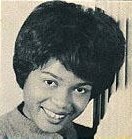
'Little Eva' Boyd, 1960s.
Readers of “The Loco-Motion” story may also find “1960s Girl Groups” of interest, which also includes a section on the 1960s’ Brill Building songwriters. And a more detailed account of the lives of Gerry Goffin and Carole King and their song-writing success is found at “Goffin and King.” Additional stories on song histories, artist profiles, and the pop music business can be found at the “Annals of Music” category page.
Thanks for visiting — and if you like what you find here, please make a donation to help support the research and writing at this website. Thank you. – Jack Doyle
|
Please Support Thank You |
________________________________
Date Posted: 7 March 2011
Last Update: 30 May 2018
Comments to: jdoyle@pophistorydig.com
Article Citation:
Jack Doyle, “The Loco-Motion, 1962-1988,”
PopHistoryDig.com, March 7, 2011.
____________________________________
Sources, Links & Additional Information
Greg Shaw, “Brill Building Pop,” in Anthony DeCurtis and James Henke, with Holly George-Warren (eds), The Rolling Stone Illustrated History of Rock n Roll, New York: Random House, revised edition, 1992, pp. 143-152.
“Pop Music: The Dumb Sound,” Saturday Evening Post, October 5, 1963.
“The Sound of the Sixties,” Time, Friday, May. 21, 1965.
David Kamp, “The Hit Factory,” Vanity Fair, November 2001, also at David Kamp.com
“The Locomotion,”Wikipedia.org.
“Little Eva,” History-of-Rock.com.
“The Loco-Motion by Grand Funk,” Song Facts.com.
Grand Funk Railroad, Official Web Site.
“Kylie Minogue and Michael Parkinson Lead List With Heroes of Summer Floods,” The Times, December 29, 2007.
Josh Tyrangiel, “Skin Deep and Proud of It,” Time, Monday, April 8, 2002.
YouTube video, Kylie Minogue, “The Loco-Motion.”
Richie Unterberger, Song Review, “The Loco-Motion by Little Eva,” AllMusic.com.
Dave Marsh, “Little Eva – The Loco-Motion, No. 55,” The Heart of Rock and Soul: The 1001 Greatest Singles Ever Made, 1989.
Spencer Leigh, “Little Eva: Singer of ‘The Locomotion’, a No 1 Hit for Her in 1962 When She Was Just 19,” The Independent (London), April 11, 2003.
_______________________________
